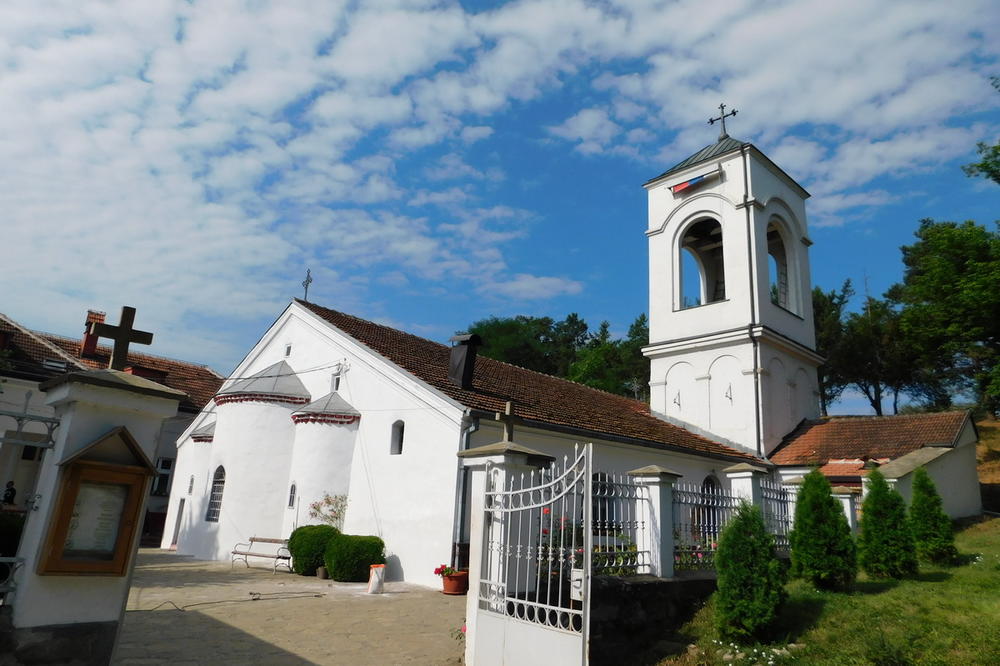The relics of Saint Prokopius were brought from Niš to Prokuplje in 1386, just before the battle on Pločnik.
The sarcophagus of the holy warrior was rescued from the Turkish invasion, but he already had the function of a “covenant coffin” to help the Serbian army. It was a moral impetus for the warriors of Prince Lazar, who badly defeated Murat’s army in the battle of Plonik near Prokuplje – says archaeologist Julka Kuzmanovic Cvetkovic, director of the National Museum in Toplica.
The significance of the relics of Saint Prokopius is evidenced by the fact that after the battle in Kosovo, the entire secret ship of the church where they were hidden was built.
The relics of Saint George, the patron saint of Nemanjic Dynasty, have come a long way to Prokuplje from Stari Ras, (Serbia) from King Stefan Nemanja’s endowment of Djurdjev’s Pillars (Djurdjevi Stupovi). The monastery was destroyed by the Turks in 1689 and it is believed that the relics were destroyed until 1880 when Mile Pesic, a native of the village of Lopiznje near Sjenica, came to the redeeming church. He brought a purplish casket lined with purple brocade, richly embroidered with gold thread, and with it the pieces of St. George’s wax-colored hands and a part of the skin of the head with blonde curls.
Pesic said the relics were hidden in the church of St. George in Lopiza. When the Turks burned down the temple, the Pesic family took the relic for safekeeping.
The Pesic family are vowed to hand over the relics to the nearest church as soon as Serbia is liberated from the Turks. Sava Pesic left the village of Lopiznja before the Turkish coup and moved to Pretreznja . The testament was passed on to son Mileta, who brought the relics to the church in Prokuplje – says Priest Nikola Ilic, head of the church of St. Prokopius.
The authenticity of the relics of St. George in the Prokuplje church was confirmed in 1929 by academician Radoslav Grujic, and one of the proofs was a graphic with scenes of the anguish of St. George glued to the inside of the coffin. The artwork was already at first glance the work of Hristofor Zefarovic, who lived and worked in Vojvodina. The question remains, where did the sarcophagus with relics from Djurdjev’s pillars go and how did it return to Old Serbia.
Thus closed the long journey of the relics of St. George in Toplica, the first principality of Emperor Stefan Nemanja from which he set out to create a large medieval Serbian state.
Unfortunately, Serbia does not know what kind of shrines there are in the Church of St. Procopius. Destiny determined that in the warrior city of Toplica rests the relics of two holy warriors Prokopius and Georgiou, who were dukes of Emperor Diocletian and were both killed because of the Christian faith in the same year of 303 – says the priest Nicholas.
Scientists agree that the Church of St. Prokopius, by which Prokuplje is named, is an incredible but forgotten gem.
The church was consecrated in 934, but excavations have shown that it is several centuries older. The original basilica was erected around the fifth century, probably over the tomb of a significant Christian martyr – says Julka Kuzmanovic.
In the churchyard, the remains of another large early Christian church were recently discovered, made with the contempt of ancient baths.
The size of the building indicates that the Roman Hameum, the predecessor of present-day Prokuplje, was a large city in the first and second centuries. After the officialization of Christianity, thermal spas are often converted into churches, and this also happened in Hameum, later called Toplice. When the relics of Saint Prokopius were brought to the city, it was named Prokuplje – our interlocutor explains.
According to existing testimonies, a look similar to the present day church of the redeeming was given at the beginning of the 10th century.
At that time a large central nave was erected on the church dedicated to the Mother of God. In h.onor of the great event of 911, when the Virgin Mary of Toplica Christians appeared in the church of Vlaherni, then the Serbs, built a large three-nave basilica on the foundations of an old temple of impressive dimensions. This is an old cathedral episcopal church, in which some of the apostles probably preached – says the priest Ilic
The present height of the church nave is 6.3 meters lower than the actual one, since the ground was still one meter behind the floor, from the time when the Turks forbade the church to be larger than the mosque, so that the earth was filled both around and inside the building.
People from all Serbian countries came to the crypt, the ranks were as in monastery Ostrog in front of St. Basil of Ostrog relics, because many healings took place by the relics of St. Prokopius – says the priest Nikola.

